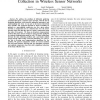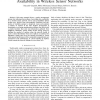512 search results - page 44 / 103 » Data Quality and Query Cost in Wireless Sensor Networks |
INFOCOM
2010
IEEE
13 years 5 months ago
2010
IEEE
We address the problem of efficiently gathering correlated data from a wireless sensor network, with the aim of designing algorithms with provable optimality guarantees, and unders...
ICC
2009
IEEE
14 years 2 months ago
2009
IEEE
—The use of variable data rate can reduce network latency and average power consumption, and automatic rate selection is critical for improving scalability and minimizing network...
ANSS
2007
IEEE
14 years 2 months ago
2007
IEEE
Data propagation in wireless sensor networks is usually performed as a multihop process. To deliver a single message, the resources of many sensor nodes are used and a lot of ener...
INFOCOM
2009
IEEE
14 years 2 months ago
2009
IEEE
— This paper presents Pirrus, a replica management system that addresses the problem of providing data availability on a wireless sensor network. Pirrus uses probabilistic failur...
ICC
2007
IEEE
14 years 2 months ago
2007
IEEE
—Slepian-Wolf coding is a promising distributed source coding technique that can completely remove the data redundancy caused by the spatially correlated observations in wireless...


